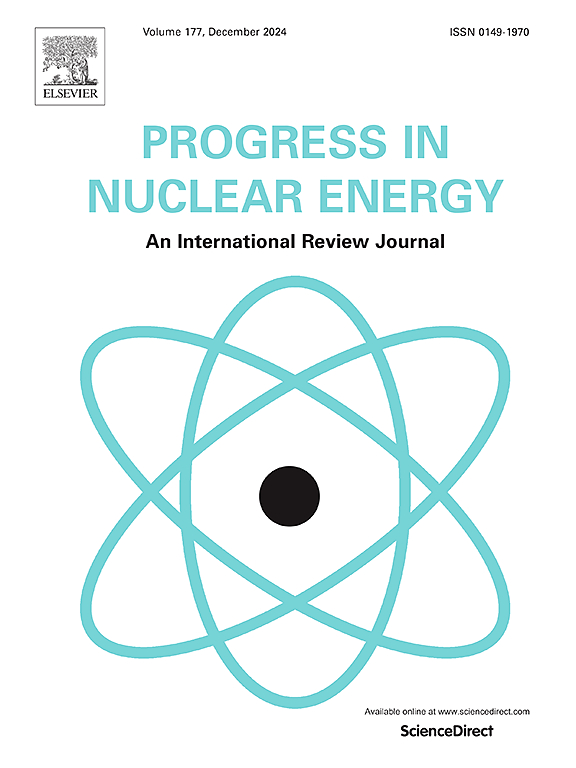The neutronic analysis of heat pipe-cooled traveling wave reactors utilizing natural uranium
IF 3.3
3区 工程技术
Q1 NUCLEAR SCIENCE & TECHNOLOGY
引用次数: 0
Abstract
The traveling wave reactor utilizing natural uranium fuel can achieve enhanced economic performance. This paper presents two novel designs for a heat pipe cooled traveling wave reactor (HPTWR) that incorporates natural uranium. In the initial HPTWR design, the reactor features an ignitor region containing high-assay low-enrichment uranium (HALEU) (20% and 10%) and a breeder region utilizing natural uranium fuel at 0.72% enrichment. The core is configured as a hexagonal prism and consists of 1242 individual UN fuel elements. Each fuel element is a smaller hexagonal prism with a heat pipe channel at its center. The current design employs a lithium and molybdenum/rhenium (Mo/Re) heat pipe. Simulation results indicate that at the beginning of the cycle (BOC), the core reactivity is substantial, with a Keff value reaching 1.36. The power profile is asymmetric, peaking in the ignition region. After 175 years of operation, when the traveling wave propagates into the breeding region, the power profile assumes a relatively symmetric form. An improved HPTWR design is then proposed, in which the fuel concentration and enrichment of 235U are adjusted axially in the extended ignition region. This adjustment results in a more symmetric power profile and a significantly lower Keff of 1.055 at BOC. The initial HPTWR design can achieve a refueling cycle of 350 years with a thermal power output of 100 MW, while the improved HPTWR design can attain a refueling cycle of 335 years with the same breeder region and power level.
求助全文
约1分钟内获得全文
求助全文
来源期刊

Progress in Nuclear Energy
工程技术-核科学技术
CiteScore
5.30
自引率
14.80%
发文量
331
审稿时长
3.5 months
期刊介绍:
Progress in Nuclear Energy is an international review journal covering all aspects of nuclear science and engineering. In keeping with the maturity of nuclear power, articles on safety, siting and environmental problems are encouraged, as are those associated with economics and fuel management. However, basic physics and engineering will remain an important aspect of the editorial policy. Articles published are either of a review nature or present new material in more depth. They are aimed at researchers and technically-oriented managers working in the nuclear energy field.
Please note the following:
1) PNE seeks high quality research papers which are medium to long in length. Short research papers should be submitted to the journal Annals in Nuclear Energy.
2) PNE reserves the right to reject papers which are based solely on routine application of computer codes used to produce reactor designs or explain existing reactor phenomena. Such papers, although worthy, are best left as laboratory reports whereas Progress in Nuclear Energy seeks papers of originality, which are archival in nature, in the fields of mathematical and experimental nuclear technology, including fission, fusion (blanket physics, radiation damage), safety, materials aspects, economics, etc.
3) Review papers, which may occasionally be invited, are particularly sought by the journal in these fields.
 求助内容:
求助内容: 应助结果提醒方式:
应助结果提醒方式:


